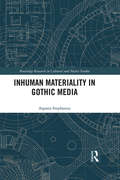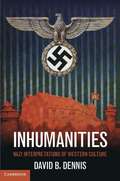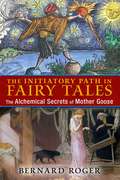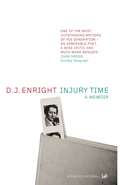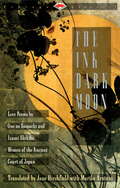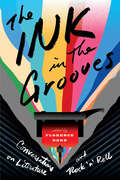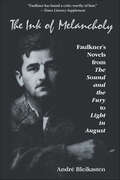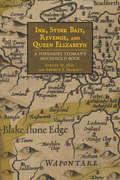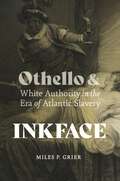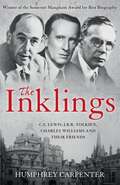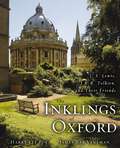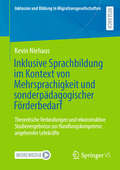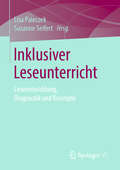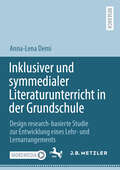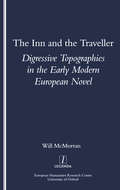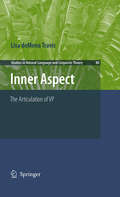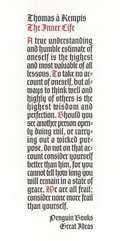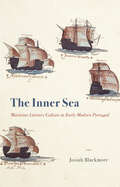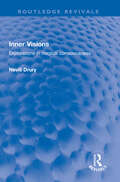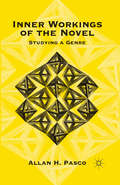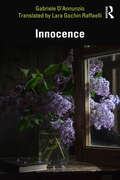- Table View
- List View
Inhuman Materiality in Gothic Media (Routledge Research in Cultural and Media Studies)
by Aspasia StephanouThis book examines the manifestations of materiality across different gothic media to show the inhuman at the heart of literature, film and contemporary media, outlining a philosophy of horror that deals with the horror of the nonhuman, the machine and the nonorganic. The author explores how materiality lends itself ideally to discussions of gothic and horror and acts as a threat to attempts to control meaning which falls outside the realm of consciousness. It brings the two together by examining the manifestations of this materiality to focus on a form of horror that is concerned with the (in) human by reading blood as the conduit of an unnameable materiality that circulates through gothic media, seducing with its familiar mask of gothic aesthetics only to uncover the horror of a totally alienating and inhuman otherness. Film, media, popular culture, philosophy and nineteenth-century literature are brought together and juxtaposed to create a continuity of ideas, and highlighting differences. The book offers innovative readings of notions of blood inscription in different media, of the Dark Web, accelerationism and technoscience to account for the widespread haemophilia in contemporary culture. This title is an essential read for researchers, undergraduate and postgraduate students in film studies, media studies, literature, philosophy, cultural theory and popular culture. Its interdisciplinary nature, clear exposition of thought and theoretical ideas will make it a key resource for both students and for general readers with an interest in contemporary horror, media and pop culture.
Inhumanities
by David B. DennisInhumanities is an unprecedented account of the ways Nazi Germany manipulated and mobilized European literature, philosophy, painting, sculpture and music in support of its ideological ends. David B. Dennis shows how, based on belief that the Third Reich represented the culmination of Western civilization, culture became a key propaganda tool in the regime's program of national renewal and its campaign against political, national and racial enemies. Focusing on the daily output of the Völkischer Beobachter, the party's official organ and the most widely circulating German newspaper of the day, he reveals how activists twisted history, biography and aesthetics to fit Nazism's authoritarian, militaristic and anti-Semitic world views. Ranging from National Socialist coverage of Germans such as Luther, Dürer, Goethe, Beethoven, Wagner and Nietzsche to 'great men of the Nordic West' such as Socrates, Leonardo and Michelangelo, Dennis reveals the true extent of the regime's ambitious attempt to reshape the 'German mind'.
Initial Language Teacher Education (Research and Resources in Language Teaching)
by Gabriel Díaz MaggioliInitial Language Teacher Education provides language teacher researchers, as well as teachers of teachers, with an introduction to research on how language teachers learn to teach before they begin practicing. Theoretical work is organized into the author’s original framework, which fosters the exploration of student teachers’ experiences as learners, while helping them develop core concepts, practices, and dispositions that encourage excellence in teaching. This innovative framework also provides mediated learning experiences designed around student teachers’ professional development, an approach that helps them to theorize their own practices and take ownership of their own professional development at an intellectual level. By combining a strong and updated research base with practical classroom tools that have been extensively piloted, Initial Language Teacher Education bridges the gap between theory and practice in teacher education and is a key resource for students, researchers, and instructors in language teaching.
The Initiatory Path in Fairy Tales: The Alchemical Secrets of Mother Goose
by Bernard RogerHidden within age-old classic stories lie the hermetic teachings of alchemy and Freemasonry • Explains how the stages of the Great Work are encoded in both little known and popular stories such as Cinderella, Snow White, and Little Red Riding Hood • Reveals the connection between Mother Goose and important esoteric symbols of the Western Mystery tradition • Demonstrates the ancient lineage of these stories and how they originated as the trigger to push humanity toward higher levels of consciousness In his Mystery of the Cathedrals, the great alchemist Fulcanelli revealed the teachings of the hermetic art encoded in the sculpture and stained glass of the great cathedrals of Europe. What he did for churches, his disciple Bernard Roger does here for fairy tales. Through exhaustive analysis of the stories collected by the Brothers Grimm, Perrault, and others, Roger demonstrates how hermetic ideas, especially those embodied in alchemy and Freemasonry, can be found in fairy tales, including such popular stories as Cinderella, Snow White, Sleeping Beauty, and Little Red Riding Hood as well as the tales attributed to “Mother Goose.” The goose has long been an important esoteric symbol in the Western Mystery tradition. The stories told under the aegis of Mother Goose carry these symbols and secrets, concealed in what hermetic adepts have long called “the language of the birds.” Drawing upon the original versions of fairy tales, not the sanitized accounts made into children’s movies, the author reveals how the tales illustrate each stage of the Great Work and the alchemical iterations required to achieve them. He shows how the common motif of a hero or heroine sent in search of a rare object by a sovereign before their wishes can be granted is analogous to the Masonic quest for the lost tomb of Hiram or the alchemist’s search for the fire needed to perform the Great Work. He also reveals how the hero is always aided by a green bird, which embodies the hermetic understanding of the seed and the fruit. By unveiling the secret teachings within fairy tales, Roger demonstrates the truly ancient lineage of these initiatory stories and how they originated as the trigger to push humanity toward higher levels of consciousness.
Injury Time: A Memoir
by D. J. EnrightThe distinguished poet, essayist and critic D. J. Enright died on the last day of December 2002. He had just put the finishing touches to Injury Time, a memoir and his third commonplace book in which the dying writer muses upon his own condition and that of the world he knows he is leaving. Comparing himself to the Chinese scholar Sima Qian, who chose an 'ignoble punishment' (in Dennis Enright's case, treatment for his cancer; in Qian's, castration) over respectable death in order to finish a book, he contemplates literature, manners, morals, people and, especially, the English language in all its glories and eccentricities - while recording his battle against cancer and his hospital experiences. Moving, and at times deeply poignant, imbued with its author's legendary humanity and wit, Injury Time is, nevertheless, funny, bracing and, above all, positive.
The Ink Dark Moon
by Mariko Aratani Jane Hirshfield Izumi Shikibu No Komachi OnoThese translated poems were written by 2 ladies of the Heian court of Japan between the ninth and eleventh centuries A.D. The poems speak intimately of their authors' sexual longing, fulfillment and disillusionment.
The Ink in the Grooves: Conversations on Literature and Rock 'n' Roll
by Florence DoreDrop the record needle on any vinyl album in your collection, then read the first pages of that novel you've been meaning to pick up—the reverberations between them will be impossible to miss. Since Dylan went electric, listening to rock 'n' roll has often been a surprisingly literary experience, and contemporary literature is curiously attuned to the history and beat of popular music. In The Ink in the Grooves, Florence Dore brings together a remarkable array of acclaimed novelists, musicians, and music writers to explore the provocatively creative relationship between musical and literary inspiration: the vitality that writers draw from a three-minute blast of guitars and the poetic insights that musicians find in literary works from Shakespeare to Southern Gothic. Together, the essays and interviews in The Ink in the Grooves provide a backstage pass to the creative processes behind some of the most exciting and influential albums and novels of our time.Contributors: Laura Cantrell, Michael Chabon, Roddy Doyle, Bob Dylan, Steve Earle, William Ferris, Dom Flemons, Rhiannon Giddens, Dave Grohl, Peter Guralnick, Amy Helm, Randall Kenan, Jonathan Lethem, Greil Marcus, Rick Moody, Lorrie Moore, the John Prine band (Dave Jacques, Fats Kaplin, Pat McLaughlin, Jason Wilber), Dana Spiotta, John Jeremiah Sullivan, Richard Thompson, Scott Timberg, Daniel Wallace, Colson Whitehead, Lucinda Williams, Warren Zanes.
The Ink of Melancholy: Faulkner's Novels from The Sound and the Fury to Light in August
by André BleikastenInk of Melancholy re-examines and re-evaluates William Faulkner's work from the late 1920s to the early 1940s, one of his most creative periods. Rather than approach Faulkner's fiction through a prefabricated grid, André Bleikasten concentrates on the texts themselves—on the motivations and circumstances of their composition, on the rich array of their themes, structures, textures, points of emphasis and repetition, as well as their rifts and gaps—while drawing on the resources of philosophy, psychoanalysis, anthropology. Brilliant in its thought and argument, Ink of Melancholy is one of the most insightful and stimulating studies of Faulkner's work.
Ink, Stink Bait, Revenge, and Queen Elizabeth: A Yorkshire Yeoman's Household Book
by Steven W. May Arthur F. MarottiIn Ink, Stink Bait, Revenge, and Queen Elizabeth, Steven W. May and Arthur F. Marotti present a recently discovered "household book" from sixteenth-century England. Its main scribe, John Hanson, was a yeoman who worked as a legal agent in rural Yorkshire. His book, a miscellaneous collection of documents that he found useful or interesting, is a rare example of a middle-class provincial anthology that contains, in addition to works from the country's cultural center, items of local interest seldom or never disseminated nationally. Among the literary highlights of the household book are unique copies of two ballads, whose original print versions have been lost, describing Queen Elizabeth's procession through London after the victory over the Spanish Armada; two poems attributed to Elizabeth herself; and other verse by courtly writers copied from manuscript and print sources. Of local interest is the earliest-known copy of a 126-stanza ballad about a mid-fourteenth-century West Yorkshire feud between the Eland and Beaumont families. The manuscript's utilitarian items include a verse calendar and poetic Decalogue, model legal documents, real estate records, recipes for inks and fish baits, and instructions for catching rabbits and birds. Hanson combined both professional and recreational interests in his manuscript, including material related to his legal work with wills and real estate transactions.As May and Marotti argue in their cultural and historical interpretation of the text, Hanson's household book is especially valuable not only for the unusual texts it preserves but also for the ways in which it demonstrates the intersection of the local and national and of popular and elite cultures in early modern England.
Inkface: Othello and White Authority in the Era of Atlantic Slavery (Writing the Early Americas)
by Miles P. GrierIn Inkface, Miles P. Grier traces productions of Shakespeare's Othello from seventeenth-century London to the Metropolitan Opera in twenty-first-century New York. Grier shows how the painted stage Moor and the wife whom he theatrically stains became necessary types, reduced to objects of interpretation for a presumed white male audience. In an era of booming print production, popular urban theater, and increasing rates of literacy, the metaphor of Black skin as a readable, transferable ink became essential to a fraternity of literate white men who, by treating an elastic category of marked people as reading material, were able to assert authority over interpretation and, by extension, over the state, the family, and commerce. Inkface examines that fraternity’s reading of the world as well as the ways in which those excluded attempted to counteract it.
The Inklings: C. S. Lewis, J. R. R. Tolkien And Their Friends
by Humphrey CarpenterCritically acclaimed, award-winning biography of CS Lewis, JRR Tolkien and the brilliant group of writers to come out of Oxford during the Second World War. C.S. Lewis, J.R.R. Tolkien and their friends were a regular feature of the Oxford scenery in the years during and after the Second World War. They drank beer on Tuesdays at the ‘Bird and Baby’, and on Thursday nights they met in Lewis’ Magdalen College rooms to read aloud from the books they were writing; jokingly they called themselves ‘The Inklings’. C.S. Lewis and J.R.R. Tolkien first introduced The Screwtape Letters and The Lord of the Rings to an audience in this company and Charles Williams, poet and writer of supernatural thrillers, was another prominent member of the group. Humphrey Carpenter, who wrote the acclaimed biography of J.R.R. Tolkien, draws upon unpublished letters and diaries, to which he was given special access, in this engrossing story.
The Inklings of Oxford: C. S. Lewis, J. R. R. Tolkien, and Their Friends
by Harry Lee Poe James Ray VenemanOxford’s fabled streets echo with the names of such key figures in English history as Edmund Halley, John Wycliffe, and John and Charles Wesley. Of more recent times are those of C. S. Lewis, J. R. R. Tolkien, and the other members of the renowned literary circle to which they belonged, the Inklings. What would it be like to walk this medieval city’s narrow lanes in the company of such giants of Christian literature, to visit Magdalen College, where Lewis and Tolkien read aloud their works-in-progress to their friends, or the Eagle and Child pub, the Inklings’ favorite gathering place? The lavish photography of this book will introduce you to the fascinating world of the Inklings, matching their words to the places where these friends discussed—and argued over—theology, philosophy, ancient Norse myth, and Old Icelandic, while writing stories that were to become classics of the faith. The Inklings of Oxford will deepen your knowledge of and appreciation for this unique set of personalities. The book also features a helpful map section for taking walking tours of Oxford University and its environs.
Inklusive Sprachbildung im Kontext von Mehrsprachigkeit und sonderpädagogischer Förderbedarf: Theoretische Verbindungen und rekonstruktive Studienergebnisse zur Handlungskompetenz angehender Lehrkräfte (Inklusion und Bildung in Migrationsgesellschaften)
by Kevin NiehausDie vorliegende interdisziplinäre Arbeit verbindet die Fachperspektive Deutsch als Zweitsprache (im Bereich Mehrsprachigkeit) mit der erziehungs- und bildungswissenschaftlichen Heterogenitäts- und Inklusionsforschung in der gemeinsamen Schnittstelle einer Inklusiven Sprachbildung. Neben theoretischen Aufarbeitungen nimmt die Arbeit die Handlungskompetenz angehender Lehrkräfte der Sekundarstufe I in den Blick und fokussiert dabei habituell-handlungsleitende Orientierungen in den Bereichen Sprachbildung, migrationsbedingter Mehrsprachigkeit und Inklusion.
Inklusiver Leseunterricht: Leseentwicklung, Diagnostik und Konzepte
by Lisa Paleczek Susanne SeifertNeben entwicklungstheoretischen Aspekten zeigt das Buch Gelingensfaktoren effektiven Leseunterrichts in inklusiven Settings auf und stellt konkrete Umsetzungsvorschläge vor. Wiederholt wird betont, dass dabei die Diversität der Voraussetzungen, die die Kinder mitbringen, stets wertschätzend Berücksichtigung finden soll. Der Inhalt Entwicklung der Lese(teil-)fähigkeiten • Zusammenhänge der Lesefähigkeiten mit anderen Fähigkeiten• Österreichischer RahmenLesePlan • Transitionsprozesse • Diagnostik von Lesefähigkeiten und anderen leserelevanten Fähigkeiten • Response to Intervention • Inklusiver Schriftspracherwerb • Fortbildungsreihe Didaktische Pakete • Fachintegriertes Leseflüssigkeitstraining Filius • Kooperative Lernmethoden • Digitalisierung im Leseunterricht • Leseförderprogramm LARS Die Herausgeberinnen Mag.a Mestre Lisa Paleczek, PhD arbeitet im Bereich Inklusion an der Kirchlichen Pädagogischen Hochschule Graz und ist Lektorin im Bereich Integrationspädagogik und Heilpädagogische Psychologie an der Karl-Franzens-Universität Graz. Lehr- und Forschungsschwerpunkte: inklusive Unterrichtsgestaltung, Erstellung differenzierter Lesematerialien für die Primarstufe, Diagnostik, Sprach- und Leseentwicklung bei Kindern mit anderen Erstsprachen. Dipl.-Patholing.in Susanne Seifert, PhD arbeitet im Bereich Integrationspädagogik und Heilpädagogische Psychologie an der Karl-Franzens-Universität Graz. Lehr- und Forschungsschwerpunkte: Leseintervention, Diagnostik von Lese- und Sprachfähigkeiten, differenzierte Lesemethoden, Lesen bei Kindern mit anderen Erstsprachen.
Inklusiver und symmedialer Literaturunterricht in der Grundschule: Design research-basierte Studie zur Entwicklung eines Lehr- und Lernarrangements
by Anna-Lena DemiAnna-Lena Demi legt in diesem Buch ein Lehr- und Lernarrangement für einen inklusiven und symmedialen Literaturunterricht (ISLU) in der Grundschule vor, welches die Bereiche Inklusion, Literaturunterricht und Mediendidaktik integriert. Im Möglichkeitsraum Literaturunterricht können Schüler*innen aller Diversitätsdimensionen gemeinsam Literatur in medial vielfältiger Form erleben und selbstbestimmte Handlungspraxen entwickeln. Die empirischen Ergebnisse zeigen, dass ISLU Schüler*innen ermöglicht, neue Rezeptions- und Produktionspraktiken souveräner zu nutzen und individuelle Formen kinderkulturellen Selbstausdrucks zu entwickeln und zeigen zugleich Potenziale für eine inklusive Medienbildung auf.
Inky Fingers: The Making of Books in Early Modern Europe
by Anthony GraftonThe author of The Footnote reflects on scribes, scholars, and the work of publishing during the golden age of the book. From Francis Bacon to Barack Obama, thinkers and political leaders have denounced humanists as obsessively bookish and allergic to labor. In this celebration of bookmaking in all its messy and intricate detail, renowned historian Anthony Grafton invites us to see the scholars of early modern Europe as diligent workers. Meticulously illuminating the physical and mental labors that fostered the golden age of the book—the compiling of notebooks, copying and correction of texts and proofs, preparation of copy—he shows us how the exertions of scholars shaped influential books, treatises, and forgeries. Inky Fingers ranges widely, tracing the transformation of humanistic approaches to texts in the seventeenth and eighteenth centuries and examining the simultaneously sustaining and constraining effects of theological polemics on sixteenth-century scholars. Grafton draws new connections between humanistic traditions and intellectual innovations, textual learning and craft knowledge, manuscript and print. Above all, Grafton makes clear that the nitty-gritty of bookmaking has had a profound impact on the history of ideas—that the life of the mind depends on the work of the hands.
The Inn and the Traveller: Digressive Topographies in the Early Modern European Novel
by Will McMorran"In the landscape of the early modern European comic novel the inn often features as a monument to digression - the perfect setting for chance encounters with strangers who always have a story to tell. This wide-ranging comparative study explores the special part played by the inn, tracing the progress of a succession of wayward heroes and narrators in five canonical texts: Cervantes's ""Don Quijote"", Scarron's ""Roman comique"", Fielding's ""Joseph Andrews"" and ""Tom Jones"", Sterne's ""Tristram Shandy"" and Diderot's ""Jacques le fataliste"". As this celebration of digressive fiction unfolds, a very different picture emerges of the novel's rise and development."
Inner Aspect
by Lisa Demena TravisThis monograph probes the structure of the verb phrase through a cross-linguistic investigation of the syntax and morphology of relevant constructions. Evidence is provided for two event-related non-lexical projections called "inner aspect" and "event".
The Inner Life
by Thomas À KempisThroughout history, some books have changed the world. They have transformed the way we see ourselves—and each other. They have inspired debate, dissent, war and revolution. They have enlightened, outraged, provoked and comforted. They have enriched lives—and destroyed them. Now, Penguin brings you the works of the great thinkers, pioneers, radicals and visionaries whose ideas shook civilization, and helped make us who we are. Penguin's Great Ideas series features twelve groundbreaking works by some of history's most prodigious thinkers, and each volume is beautifully packaged with a unique type-drive design that highlights the bookmaker's art. Offering great literature in great packages at great prices, this series is ideal for those readers who want to explore and savor the Great Ideas that have shaped the world. The Inner Life is taken from Thomas à Kempis's The Imitation of Christ, a classic Christian devotional that has taught and inspired generations. .
The Inner Life of Women in Medieval Romance Literature
by Jeff Rider Jamie FriedmanExploration of the emotionologies of several medieval, romance emotional communities through both fictional and non-fictional narratives. The contributors analyze texts from different linguistic traditions and different periods, but they all focus on women characters.
The Inner Sea: Maritime Literary Culture in Early Modern Portugal
by Josiah BlackmoreAn expansive consideration of how nautical themes influenced literature in early modern Portugal. In this book, Josiah Blackmore considers how the sea and seafaring shaped literary creativity in early modern Portugal during the most active, consequential decades of European overseas expansion. Blackmore understands “literary” in a broad sense, including a diverse archive spanning genres and disciplines—epic and lyric poetry, historical chronicles, nautical documents, ship logs, shipwreck narratives, geographic descriptions, and reference to texts of other seafaring powers and literatures of the period—centering on the great Luís de Camões, arguably the sea poet par excellence of early modern Europe. Blackmore shows that the sea and nautical travel for Camões and his contemporaries were not merely historical realities; they were also principles of cultural creativity that connected to larger debates in the widening field of the maritime humanities. For Blackmore, the sea, ships, and nautical travel unfold into a variety of symbolic dimensions, and the oceans across the globe that were traversed in the fifteenth and sixteenth centuries correspond to vast reaches within the literary self. The sea and seafaring were not merely themes in textual culture but were also principles that created individual and collective subjects according to oceanic modes of perception. Blackmore concludes with a discussion of depth and sinking in shipwreck narratives as metaphoric and discursive dimensions of the maritime subject, foreshadowing empire’s decline.
Inner Visions: Explorations in magical consciousness (Routledge Revivals)
by Nevill DruryFirst published in 1979, Inner Visions discussion the nature of contemporary magical thought – encompassing the Tarot and the Qabalah – and considers its impact on the creative imagination. The author presents a fusion of the creative, magical and mythological undercurrents which are part of the ‘new consciousness’, and traces the influence of surrealist art and the expansive psychedelic period on the art and music of the 1970s. He looks, for example, at the relationship of the fantasy art on record sleeves to the electronic inner-space music which it often accompanies, and shows that this form of modern music represents one facet of the contemporary reaction against scientism and of the search for what Roszak has termed the visionary sources of our culture. The author concludes that a major mythological impulse is emerging in our culture and that magical and surreal approaches represent a profoundly invigorating and inspiring attitude linking the individual to the cosmos. This will be a fascinating read for anyone interested in magic, mythology, art, music and literature.
Inner Workings of the Novel
by Allan H. PascoPasco analyzes innovative nineteenth- and twentieth-century French works to suggest a definition of the novel, in all of its variations and difficulties: a relatively long, artistically designed, prose fiction. He permits literary aficionados to reevaluate novels through comparisons with other genres and both recent and former traditions.
The Inner World of Gatekeeping in Scholarly Publication
by Pejman Habibie Anna Kristina HultgrenThis edited book focuses on the certifiers of scientific knowledge, bringing together experts in a variety of areas in Applied Linguistics to address the complex topic of editing and reviewing in writing for scholarly publication. Drawing on insider perspectives, the authors bring to the fore personal histories, narratives and first-hand accounts of editors and reviewers and help paint a richer and more nuanced picture of the discourses, practices, experiences, success stories, failures, and challenges that frame and shape trajectories of both Anglophone and English as an additional language (EAL) scholars in adjudicating and accrediting academic output. This book will be of interest to researchers, practitioners, supervisors, writing mentors, early-career scholars and graduate students in a variety of fields.
Innocence
by Gabriele D'AnnunzioLara Gochin Raffaelli has produced an expert new English translation of a masterpiece of Italian literature. L'Innocente (1892) is a psychological novel by the renowned Italian author Gabriele D'Annunzio.Set in fin-de-siècle Rome and the southern Italian countryside, the story revolves around Tullio Hermil, a man entangled in his own moral failings. The novel delves into the psychological nuances of the characters and their relationships, making it an exploration of human emotions and moral dilemmas. D'Annunzio explores the depths of Tullio's psyche, exploring his twisted emotions, moral ambiguity, and descent into madness. The translation is faithful to D’Annunzio’s original, maintaining his lyrical rhythms and rich imagery, while updating previously censored content for modern readers. Key themes include the interplay of religious faith and the pursuit of sensual pleasure; the implications of patriarchal authority; and the pursuit of redemption in a morally ambiguous worldInnocence presents an uncensored version of Gabriele D’Annunzio’s famous novel. Also, featuring a rich and informative introduction from Michael J. Subialka, the novel is a valuable contribution to the fields of comparative literature, Italian studies, fin-de-siècle studies, and medical humanities.
